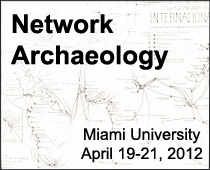Presentation by Rory Solomon (The New School).
Essential to any analysis of networked media is an understanding of the “stack.” This oft cited diagrammatic illustrates how protocol is operationalized within networked systems. Protocol, as Alex Galloway has written, is the basis on which networks function, and each protocol contains within it another – a kind of remediation for networked media. The well known network stack diagram illustrates this nesting: from the “low level” (physical wire) to succeeding “higher levels” (TCP/IP, the Web, email, etc). As a generalized concept, the stack pops up in many areas of computer science – it is the model of how functions are recursively evaluated in the theory of computation, and a data structure used by many common algorithms. Going further, we can see the stack configuration presented in other contexts such as economics and politics. The stack reveals a dualistic tension: while higher abstractions open up new space for creativity, they are also always constrained and preconditioned by “lower level” infrastructure – by the milieus and circumstances of their production.
This paper presents a media archaeology of the stack itself, beginning with its invention by German computer scientist Friedrich Bauer in 1955. The fundamental principle of the stack is that items are only added or removed from the top, creating a “last in, first out” behavior – this is essentially the gesture of archaeology itself. Archaeology proper takes the earth as its stack – excavating recent layers first, and digging deeper to lower, prior layers. Stack-based analysis then can be seen as the essential method of a network archaeology.
Rory Solomon is an artist and software engineer. He is Adjunct Faculty at Parsons and is currently pursuing an MA in Media Studies at The New School, where his thesis is a media archaeology / genealogy of computer programming. His artwork has been featured in the National Art Museum of China, the Conflux Festival and Aronson Gallery. His other research interests include databases and urban geography, and he is currently tech lead on the Urban Research Tool: a project with Shannon Mattern that is developing an open source, web-based mapping platform for urban media archaeology research.




